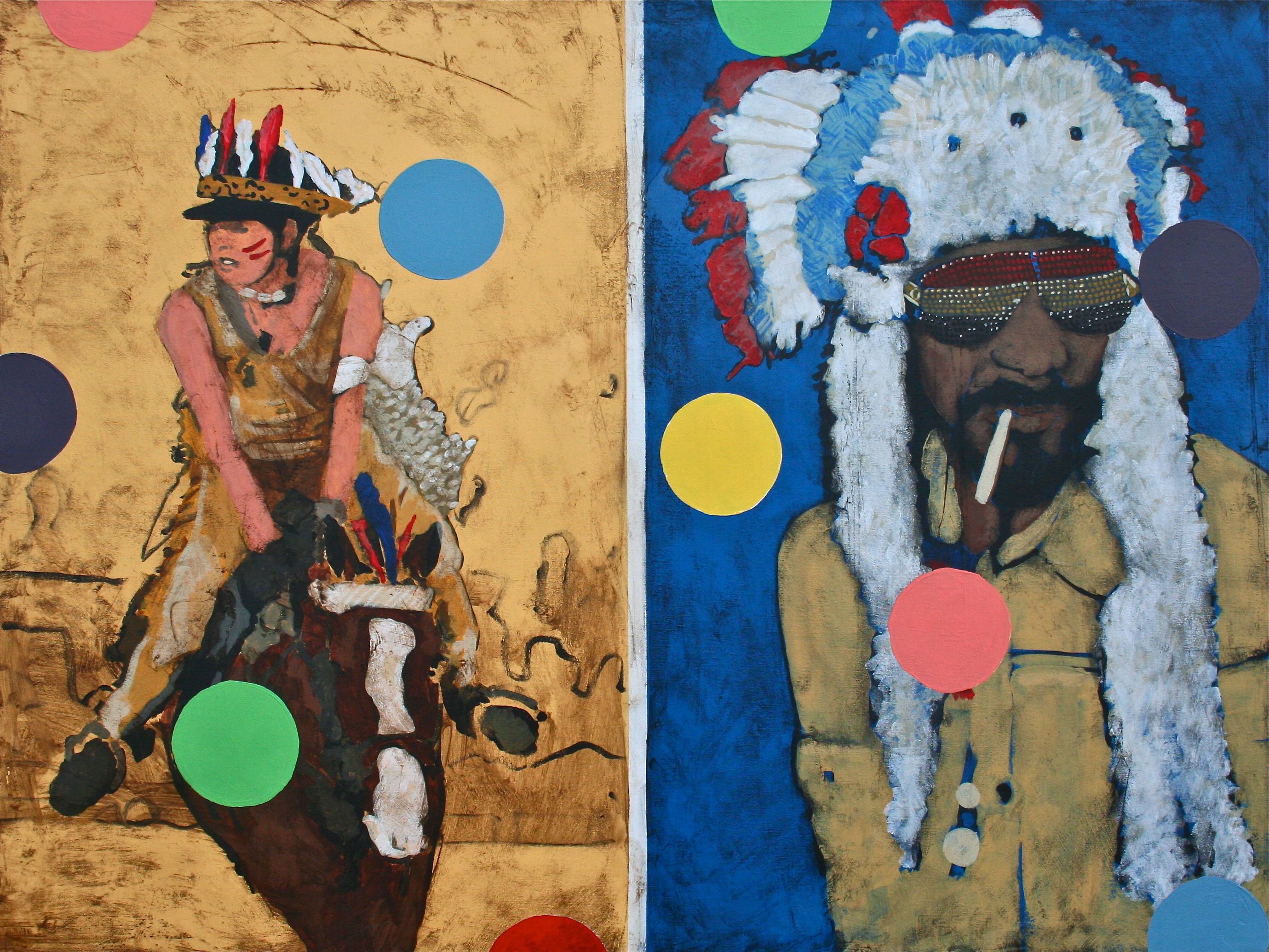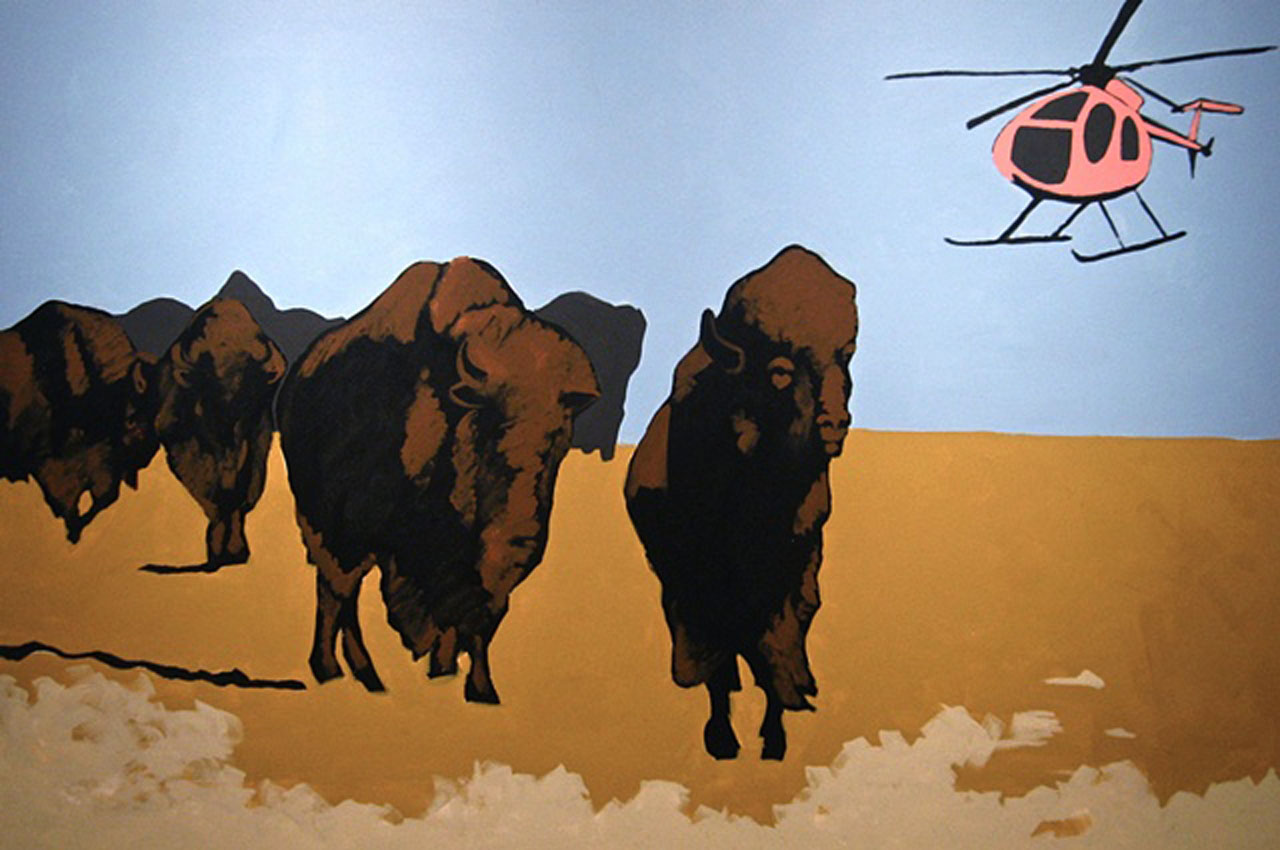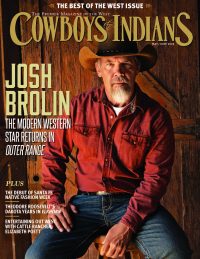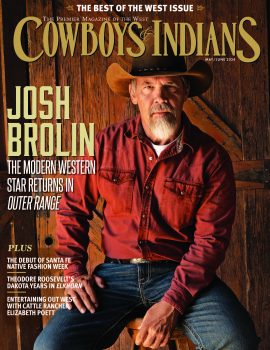
Contemporary pop culture and Native American identity come into focus in this artist's colorful cross hairs.
You can understand why Frank Buffalo Hyde would be fixated on issues of identity: A member of the Onondaga Nation, Beaver Clan, Buffalo Hyde was born without part of his arm and leg to a father who had been exposed to Agent Orange in Vietnam. As a result, the artist developed the identity of what he calls a “natural-born veteran.”
Not surprisingly, his goal for his art is to go beyond stereotypes.
His specialty is pop art that reinterprets contemporary culture — particularly as it relates to modern Native Americans. “I use popular culture and current events as fodder for my paintings,” Buffalo Hyde says. “There’s a rich well there that never seems to run dry. I put a mirror up to popular culture and redefine it.”
His heritage gives him the authenticity and license to be at the forefront of a movement in which, he says, American Indians are increasingly taking ownership of their images and how they are portrayed. Born in Santa Fe the son of Nez Perce sculptor Doug Hyde, Buffalo Hyde (his given name) grew up mostly in central New York on his mother’s Onondaga Reservation, where he often watched the tribe’s herd of buffalo, learning about their life cycle and behaviors and occasionally helping to corral them.
He began exhibiting professionally at age 18 and studied at the Santa Fe Art Institute and the Institute of American Indian Arts. Now 39, Buffalo Hyde has shown internationally — including a summer and fall 2012 exhibition of contemporary art in Russia — and in galleries from Santa Fe to Chicago and New York to San Francisco. He has also been the artist-in-residence and exhibited at the Museum of Contemporary Native Arts in Santa Fe and at the University of Virginia’s Kluge-Ruhe Aboriginal Art Collection.
Drawing images from advertisements, movies, television, music, and politics, Buffalo Hyde taps into what he describes as the collective unconsciousness of the 21st century, “overlapping imagery to mimic the way the mind holds information: nonlinear and without separation.” The result is art that breaks through the boundaries of what many people think Native American art should look like.
Take, for example, his 13-painting collection SKNDNS | Native Americans on Film, which was acquired last year by the Smithsonian Institution’s National Museum of the American Indian. Depicting the exploitation of Native American and other indigenous cultures, the paintings examine cinematic stereotypes in vaguely Warhol-esque fashion (not surprisingly, Buffalo Hyde’s Facebook page lists The Andy Warhol Museum as a favorite interest).
This largely technicolor exploration of the Native American persona on film includes Irene Bedard, Wes Studi, Sheila Tousey, Billy Jack, and, in a polka-dotted painting titled NDN FBI, Val Kilmer in Thunderheart. The artist reaches back to 1973 for Incident at the Oscars, which portrays in gray scale Apache actress Sacheen Littlefeather in traditional dress declining Marlon Brando’s Best Actor Academy Award for The Godfather as she reads his statement indicting Hollywood’s treatment of Native Americans. And Buffalo Hyde remains up to the moment with Leader of the Pack, his provocative take on Twilight’s hunky wolf pack. (Lately he has continued in the same contemporary culture-centric vein with riffs on Johnny Depp’s Tonto in a series called Tonto Scissorhands.)

One of his favored images is the buffalo, which might appear with a space shuttle, or on a can of Buffalo beer, or even with Cartman from the animated series South Park. These provocative juxtapositions, which were the focus of his recent exhibition at the Museum of Contemporary Native Art, Frank Buffalo Hyde: Ladies and Gentlemen, This Is the Buffalo Show, explore the myriad roles of his namesake animal over the centuries — from harbinger to hamburger, legend to logo.
One painting included in the show portrays Buffalo Bill with a plate of Buffalo wings flanked by the Buffalo Bills logo. Despite painting Buffalo Bill multiple times, Buffalo Hyde is not a fan of the historic showman, whom he sees as something of a victimizer (“If you really look at it, he was basically an opportunist and made a living sort of dehumanizing people”); the beast, on the other hand, comes across as a victim of both massacre and marketing. “I was commenting on how the buffalo is a powerful icon not only for Native Americans but also for popular culture,” says Buffalo Hyde.
Probing pop culture forays into contemporary identity make for arresting and thought-provoking art — and for the effective dismantling of Native stereotypes. Which is exactly Buffalo Hyde’s intention.
“I try to define that discrepancy or that space between what popular culture has labeled us as and what Native Americans really are,” he says. “The limits are endless with contemporary Native Americans. It’s time to be included in the national dialogue and international dialogue, and not be categorized as antiquity or craft.”
Tansey Contemporary in Santa Fe will present a solo exhibition of Frank Buffalo Hyde's new work March 11 – April 1, 2016. An opening reception will be held on Friday, March 4 from 5–7 p.m. The artist will be present. Hyde's Buffalo Fields Forever — To Infinity and Beyond has recently been acquired by the Museum of Indian Arts and Culture and will be featured in their Cultural Heroes show this spring.
Profile from the August/September 2013 issue.













